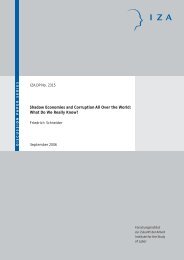The Great Recession of 2008-2009: Causes ... - Index of - IZA
The Great Recession of 2008-2009: Causes ... - Index of - IZA
The Great Recession of 2008-2009: Causes ... - Index of - IZA
- TAGS
- recession
- index
- ftp.iza.org
Create successful ePaper yourself
Turn your PDF publications into a flip-book with our unique Google optimized e-Paper software.
or reserves.<br />
5. Growth in credit default swaps (CDS) • CDO issuers purchased CDS, which enabled them to<br />
receive AAA ratings. <strong>The</strong>se purchases were not<br />
regulated as over-the-counter transactions.<br />
Source: Adapted from Astley et al. (<strong>2009</strong>) and Baily et al. (<strong>2008</strong>).<br />
As argued by Shiller (<strong>2008</strong>), ‘<strong>The</strong> housing bubble was a major cause, if not the (author’s<br />
emphasis) cause, <strong>of</strong> the subprime crisis and <strong>of</strong> the broader economic crisis...’ (Shiller <strong>2008</strong>:<br />
29). However, due to the rapid increase in securitization <strong>of</strong> mortgage bonds, this was no<br />
ordinary housing bubble ins<strong>of</strong>ar it was not only domestic lenders that were exposed to the<br />
stability <strong>of</strong> the US housing market but investors around the globe. As captured in Table 1,<br />
mortgages were sold on by the originators to third-parties, which were then repackaged as<br />
mortgage-backed securities (MBS) and sold to investors. This enabled lenders to take the<br />
loans <strong>of</strong>f their books. In particular, special investment vehicles (SIVs) were pressed into<br />
service and kept <strong>of</strong>f the balance sheet, which allowed financial institutions to increase<br />
leverage and returns on their investments. Thus, mortgages that were in the past the domain<br />
<strong>of</strong> the traditional banking system could now be traded in open markets both within the US<br />
and outside its borders, beyond the scope <strong>of</strong> regulatory measures (because they were<br />
conducted as an over-the-counter transaction thus avoiding the regulations pertaining to the<br />
stock market).<br />
<strong>The</strong> development <strong>of</strong> new complex financial products outside the scope <strong>of</strong> existing rules<br />
proved to be a major regulatory failing (Table 1). Overall, the central elements <strong>of</strong> this failure<br />
were: inadequate capital requirements on products such as the collateral debt obligations<br />
(CDOs); inadequate use <strong>of</strong> ratings and the way credit rating agencies themselves were<br />
regulated; and the incentives for risk-taking generated by structured remuneration<br />
arrangements (i.e. bonuses) (Astley et al. <strong>2009</strong>; Baily et al. <strong>2008</strong>, Bean <strong>2009</strong>; Obstfeld and<br />
Rog<strong>of</strong>f <strong>2009</strong>).<br />
This combination <strong>of</strong> a misperception <strong>of</strong> risk, lax financial regulation and low returns on<br />
riskless assets fuelled the excessive leverage and investment in risky assets, namely the<br />
mortgage-backed securities. Sub-prime mortgages were at the centre <strong>of</strong> the crisis but were by<br />
no means the cause.<br />
19
















